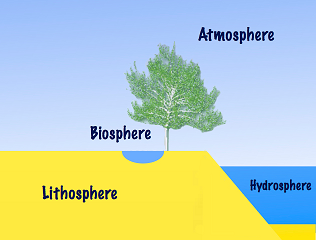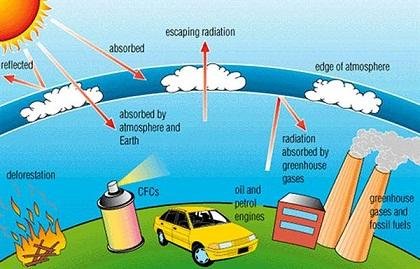The Environment
The environment is the combination of all living and non-living components on the earth and on the universe as a whole (Johnson, Ambros, Bassett, Bowen, Crummey, & Isaacson, 1997). All these components interact in what is referred to as the natural environment. The environment may be said to be natural or built. The natural environment is one that has minimal or no human influence (Odum, 2000).
On the other hand, the built environment is one that has greatly been influenced by man’s activities. The environment consists of ecological units that occur naturally. These include living components such as microorganisms and vegetation, and non-living components such as soils and rock. The atmosphere and the naturally occurring phenomena also make part of the environment.
The environment is made up of natural resources that occur naturally. These include air, water and climate. The hydrosphere, atmosphere and biosphere are the parts of the earth that support life. The hydrosphere support marine life while the biosphere supports terrestrial animals.

Fig 1: Earth’s atmosphere, biosphere and hydrosphere
Nature is a great attraction to tourists who love to explore the wild in search of adventure. However, some tourist activities may prove to be harmful to the environment and cause damages that may be irreversible. Therefore, it is important to protect and conserve the environment.
Damages to the environment mainly occur when the natural resources are strained by their overuse. Loss of biodiversity may prove to be disastrous in various ways as highlighted below.
- Loss of biodiversity may lead to loss of food supply. It also reduces the opportunities for recreation, hence threatening the sustainability of tourism. It also destroys the source of valuable medicine, timber and energy.
- The vital ecological functions may be disrupted. These include soil formation and species balance. Biodiversity also plays an important role of greenhouse gas absorption. Therefore, its unavailability translates to the absence of such services.
- It also causes a reduction of the ecosystem’s productivity. This translates to reduced quantities of natural goods and services.
- It causes the weakening of the ecosystems rendering them vulnerable to natural disasters. This means that the ecosystems would not have the ability to resist drought, floods and such stresses. Man-made stresses would also prove harmful.
Tourism
One form of human stress to the environment may be in the form of tourism. There are various forms of tourism and each has different impacts to the environment. Tourism is a term used to describe the movement of individuals to areas outside their usual place of residence. It involves the actual activity of travelling and the activities that they indulge in during their stay in the destination.
One form of tourism is wildlife tourism. In this case, tourists visit areas where wildlife is in abundance in order to view wild animals in their natural environment.
Another form is cultural tourism whereby the tourists mainly visit a destination in order to learn more about different cultures. Religious tourists, on the other hand, are those that that travel for pilgrimage. These individuals mainly travel in large masses to holy cities. Such cities include Varanasi, Jerusalem and Mecca.
Another form of tourism is sports tourism. In this case, individuals visit other places either to view or participate in sporting events. This mainly occurs when there is a sporting event such as the Olympics. Some tourists travel for the sole purpose of rebuilding their health and stamina.
They are referred to as health or medical tourists. It involves traveling great distances in search of medical treatment. One of the advantages of this is the issue of reduced costs. Some also enjoy alternative forms of therapy such as those experienced in hot springs. Other forms of tourism include educational tourism, business tourism and family tourism.
There are alternative forms of tourism that greatly differ from traditional tourism since they strive to establish a mutual relationship between the tourists and the local communities (Eadington & Smith, 1992).
Alternative tourism is vital in today’s world since it is a key driver of sustainability and sustainable development. One of these forms is ecotourism. Several benefits are tied to this form of tourism since it encourages conservation and preservation of the environment.
Tourism-environment Relationship
Some forms of tourism may be a source of great disturbances to the animals and a catalyst of biodiversity depletion. One of the ways in which tourism may be harmful to the environment is whereby tourist resorts and hotels are developed in fragile ecosystems such as mangroves and rainforests (Davis, 2000). This causes the destruction of microenvironments hence destruction of life.
Wildlife viewing may also be disadvantageous in several ways. Some activities such as feeding and nesting may be disrupted as animals run away for safety. Opening up of forests may also push away animals that prefer to live in forested areas. Deforestation may also contribute to climate change since the plant cover necessary to absorb greenhouse gas is reduced during development of infrastructure that supports tourism.
Another impact of tourism to the environment is the introduction of exotic species. As tourists travel around, they may unknowingly carry with them insects, plants (seeds) or diseases from their places of origin. When these elements are introduced to the area of destination, they may flourish and cause destruction. This may cause disruptions to the ecosystem or cause complete destruction.
Global tourism accounts for approximately 50% of traffic movements. This translates to huge volumes of carbon dioxide being released during the burning of fuel in automobiles and aircrafts. The release of carbon dioxide and other greenhouse gases to the environment causes a blanketing effect in the atmosphere and therefore causes global warming.
Effects of global warming include the rise in atmospheric temperatures, the decrease in snow cover in the poles and the rise in sea level. Global warming may also cause severe and unseasonal weather (Karl, Melillo, Peterson, & Hassol, 2009).

Fig 2: Sources of greenhouse gases and effects on global warming
Ecotourism
Ecotourism is one of the forms of tourism that supports sustainable development (Bar-kin, 2002). It is whereby tourists travel to natural areas with the aim of promoting conservation. Such tourists also value the community living around the conservation areas. Therefore, they strive to improve the people’s well being and lifestyles. For this reason, there are principles that guide ecotourism activities. These principles include the following.
- Building environmental awareness and promoting respect
- Minimize environmental impacts
- Provide financial support towards conservation
- Support the host community financially
- Positively impact the tourists and hosts
The International Ecotourism Society (TIES)
With the increased need for the conservation of the environment, several organizations have been established globally in order to encourage ecotourism. One of the organizations established for this purpose is The International Ecotourism Society. It was founded in 1990 in order to spearhead the concept of responsible tourism. The organization helped to define the concept of ecotourism.
It is a non-profit organization that aims at providing guidance and standards pertaining to tourism activities. The organization also provides training and distributes educational resources. The goal of this organization is to use tourism as a tool to promote protection and conservation of biodiversity. It also strives to promote sustainable development of the communities.
The organization works together with individuals, communities and organizations by providing avenues for registration for membership and also uses educational programs. These tools are used mainly to promote the principles of ecotourism. The organization trains professionals in various fields and these include the academicians, architects, tour operators, government officials, conservation personnel, among others.
The organization defines ecotourism as responsible tourism. Using the principles of ecotourism, the organization continues to provide unbiased information in the field and continues to foster sustainability of tourism activities. The organization’s mission is to promote ecotourism. This involves promoting environmental conservation and improving the lifestyles of the surrounding communities.
Ecotourism is the preferred form of tourism because it has several positive aspects. Ecotourism ensures that there is as little impact to the environment as possible. It also encourages the building of environmental and cultural awareness. This ensures that people have respect for the environment. Ecotourism also fosters community development, which gives the members incentive to conserve the environment.
Ecotourism also involves the channeling of funds into conservation efforts. This goes directly towards ensuring that flora and fauna is conserved in its natural environment. Since ecotourism also entails sensitizing the country’s environmental and political climate, it ensures that conservation is the responsibility of every citizen.
References
Bar-kin, D. (2002). Ecotourism for sustainable regional development. Current Issues in Tourism, 5(3), 245-253.
Davis, T. (2000). Sustaining the forest, the people, and the spirit. New York: State University of New York.
Eadington, W., & Smith, V. (1992). The emergence of alternative forms of tourism, in tourism alternatives: Potentials and problems in the development of tourism. Pennsylvania, USA: University of Pennsylvania Press.
Johnson, D., Ambrose, S., Bassett, T., Bowen, M., Crummey, D., & Isaacson, J. (1997). Meaning of environmental terms. Journal of Environmental Quality, 26(3), 518-589.
Karl, T., Melillo, J., Peterson, T., & Hassol, S. (2009). Global climate change impacts in the United States. Cambridge: Cambridge University Press.
Odum, E. (2000). Cycles of life. New York: Scientific American Library.